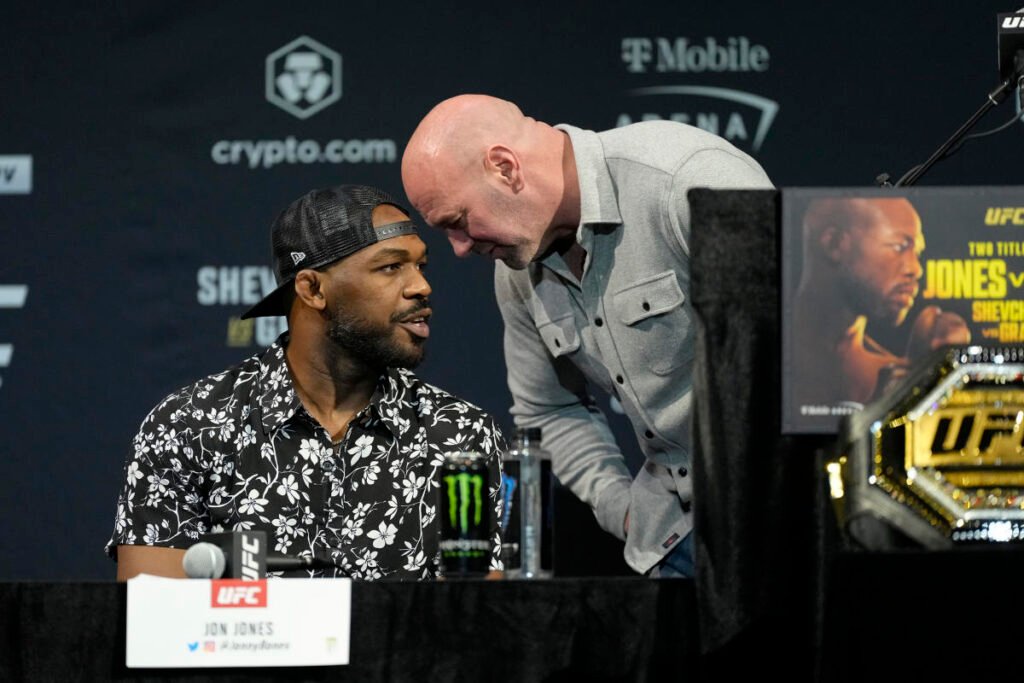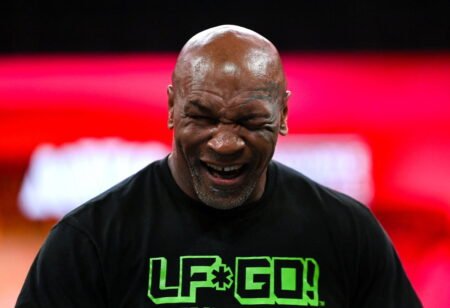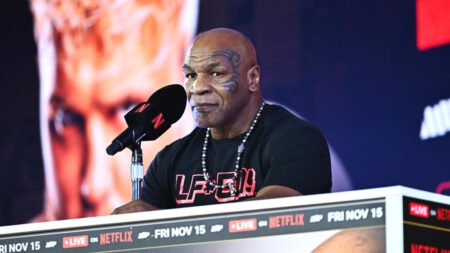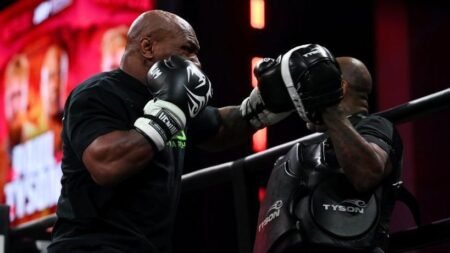Saturday at New York’s Madison Square Garden, Jon Jones defends his version of the UFC heavyweight title against an aging but perhaps underestimated Stipe Miocic at UFC 309.
His version, because Francis Ngannou hasn’t lost an MMA fight since exiting the UFC as undisputed champion two years ago, and current interim champ Tom Aspinall has a better claim to being the best active UFC heavyweight with a gold belt.
Nevertheless, the real attraction at UFC 309 is a rare, remaining opportunity to see the pound-for-pound greatest mixed martial artist of all — Jones — in action. And yet, while Jones’ status as the greatest fighter of the UFC’s first 30 years is almost unquestioned, whether he’s the best fighter in the UFC in 2024 is now hotly debated. UFC CEO Dana White has worked himself into a self-parody with his insistence that Jones, despite being 37 and having fought one round since he was 32, remains the pound-for-pound number one. But arguing who is or isn’t pound-for-pound is the lifeblood of the fight fan.
As a young boxing writer, I flew to Memphis to cover another pound-for-pound Jones — Roy Jones Jr. — in his 2004 comeback against Glen Johnson. Jones Jr.’s long run as one of the two or three best pound-for-pounders in boxing had been violently concluded by Antonio Tarver four months earlier. After the weigh-in, I tagged along to a liquid supper with several big-name scribes including the legendary Bert Sugar.
As we squeezed around a whiskey-drowned table in a Beale Street dive bar, our conversation floated from who had replaced “RJJ” as the pound-for-pound king to, inevitably, the greatest pound-for-pounder ever. Sugar slammed down his long-cemented opinion that Sugar Ray Robinson was in a class of one.
“Muhammad Ali himself admitted he copied Robinson,” he stated, chewing on the cigar that, by that age, was now merely for exhibit. “It’s hard to imagine the copy being better than the original. And — remember! — the phrase ‘pound-for-pound’ was invented for Ray by Jimmy Cannon.”
Sugar was one of boxing’s great characters and a fine historian. I was thrilled to be sitting with him and didn’t dream of correcting him.
Because while the term “pound-for-pound” was permanently installed in boxing’s lexicon by legendary sportswriter Cannon in his dispatches on Robinson’s mid-20th century tour de force, it had in fact been circulating in boxing-speak for decades.
In 1925, for example, Grantland Rice began an entire syndicated newspaper column entitled “Pound For Pound,” beginning: “Who is the best fighter in the world for his weight — pound for pound? Our vote goes to Jimmy Slattery — with Mickey Walker possibly in second place.”
Not only was the term in use a century ago, but so was the very idea of ranking fighters of different divisions against each other. Rice wasn’t alone in doing this, either. In one of The Ring Magazine’s very first issues in 1922, founder Nat Fleischer named Benny Leonard as “the most skilled fighter at any weight” ahead of legends Jack Dempsey and Harry Greb.
Three decades before that, in broadsheets made of pulped spruce paper that yellowed outside American barbershops, fighters including George Dixon, Bob Fitzsimmons, and Terry McGovern were described as “the highest of any weight,” “the best pugilist regardless of size,” and “the best pound verses pound.”
In 1989, The Ring introduced its official pound-for-pound rankings, with Mike Tyson adjudged the best boxer in the world — over Julio Cesar Chavez and Pernell Whitaker, if you can even imagine.
KO Magazine, Boxing Monthly and others soon followed. By the time of the original internet boom, the pound-for-pound discussion was so ubiquitous, SecondsOut, House of Boxing, FightNews and other early websites could scarcely write about Jones Jr., Oscar De La Hoya, Bernard Hopkins, Floyd Mayweather, Naseem Hamed, and 20 or 30 others without explicit reference to their pound-for-pound standing.
Achieving the status of being pound-for-pound No. 1 has become the True North by which generations of the most talented fighters in the world have set their career compasses. When Gen-X fans remember Jones Jr. avenging his disqualification loss to Montell Griffin in 1997, they first recall the terrifying heights of a fully motivated Jones’ talent for violence, and second, him screaming into HBO’s cameras for everyone to, “PUT ME BACK AT NUMBER ONE — CUZ THAT’S WHAT I AM!”
Jones was referencing Ring Magazine’s decision to elevate De La Hoya to pound-for-pound king in the wake of the Griffin disqualification. But what, exactly, does it mean to be judged the pound-for-pound No. 1 in boxing — or MMA, kickboxing, or any other combat sport that has weight divisions?
You don’t have to have gotten into a whiskey-drowned debate in Memphis to realize that pound-for-pound, and the very criteria it is judged on, are different things to different people. That said, they can be distilled into three principles which are separate but can sometimes overlap. Each have pros and cons.
The first is that pound-for-pound is judged résumé vs. résumé. This has the benefit of being a matter of comparing many black and white facts: How many title defenses? How many wins inside the distance? How many undefeated opponents were denied?
For a snapshot of this argument, see the current debate on who is 2024’s MMA Fighter of the Year. Alex Pereira knocked out two former champions and a top-10 contender in three impressive wins, but opinion is split between “Poatan” and those who insist Illa Topuria’s demolitions of genuine featherweight legends Alexander Volkanovski and Max Holloway are more impressive.
It may not be a coincidence that Jones, Anderson Silva, Georges St-Pierre, and Demetrious Johnson — usually the four UFC fighters named pound-for-pound GOATS — first established their legends with long reigns in single weight classes, rather than trying to shortcut their way to greatness by division hopping.
If beating world-class opposition is the ladder most fighters climb to the summit of pound-for-pound rankings, then doing so while demonstrating flamboyant skills are rocket packs. The mention of pound-for-pound shakes loose memories of Jones Jr. dodging Glen Kelly’s punches with his gloves literally behind his back, of a hands-down Silva mockingly dodging Forrest Griffin’s haymakers by millimeters and light years in concert, and Jones spearing a spinning elbow straight into Stephan Bonnar’s skull.
The second interpretation of the phrase is the most literal — and the most absurd. This is the “What if Tyson Fury could be shrunk down to fight Terence Crawford at 147 pounds” corollary.
It is, if you think about it for even a moment, a caravan of nonsense.
Fury is a great fighter because he is a 6-foot-9, 260-pound giant who moves as well as a much smaller man. If we used a Martian shrink ray to make him a much smaller man, Fury is stripped of many of the very things that makes him a special fighter — his skills, footwork, and speed in spite of his huge size.
We can underline this point by moving from Fury, a giant boxer, to a giant MMA fighter. Brock Lesnar’s short reign of terror in the late 2000s was predicated on the dual foundations of his NCAA wrestling skills and, as defending UFC heavyweight champion Randy Couture learned at UFC 91, Lesnar’s cavernous physical advantages.
Lesnar was an 18-month, 2-1 novice going into that 2008 title fight, yet he decked Couture with a bowling ball right cross and pounded out the champ out. Lesnar’s striking techniques were rudimentary. But when fists that big — UFC had to create a special XXXXL glove — are thrust out at the end of tree-trunk arms and powered by cannon ball shoulders and a back wider than the deck of an aircraft carrier, enormous power is generated, nevertheless. A 265-pound mountain of fast-twitch muscle, Lesnar was 21% bigger than the 220-pound Couture. That percentage simply could not occur in any other weight division, and there’s no such thing as a middleweight or lightweight Brock Lesnar.
The very thing that made him a champion doesn’t survive this thought experiment.
As for the third interpretation of what pound-for-pound means, this is the one preached by UFC CEO White. According to White, pound-for-pound rankings are earned by when fighters move up in weight and demonstrate that their skills can overcome great physical disadvantages. Returning for a moment to the ongoing Jones pound-for-pound debate, White seems enormously impressed by the fact Jones, a career light heavyweight, moved up to heavyweight to win the vacant belt two years ago.
It’s not an awful way to look at it. Remember, the distances between weight classes in combat sports are at least supposed to represent the limit to where two similarly skilled opponents can compete without size becoming an insurmountable advantage, so it makes sense that a smaller fighter whose talents can traverse those borders must be special.
This idea is undoubtedly what champions have in mind when they move up to challenge their larger counterparts. The first boxer to thus plant his pound-for-pound flag was George Dixon, the Canadian boxer who won the bantamweight world title in 1890 and the featherweight belt a year later.
It is interesting to note that heavyweights are historically underrepresented in both boxing and MMA pound-for-pound lists. Only half a dozen heavyweights have topped The Ring’s roll-call since 1989, and no heavyweight has been named No. 1 in the 11 years of the UFC’s in-house pound-for-pound rankings.
And yet, judged on this “talent over mass” criteria, smaller heavyweight champions like Evander Holyfield, Michael Moorer, and Oleksandr Usyk have a sound argument for the top spot. Usyk, despite weighing a career heaviest 223 pounds, still gave away 17.49% in mass to Fury earlier this year. If 122-pound super bantamweight king Naoya Inoue — Usyk’s pound-for-pound rival — faced identical adversity, he’d be in the ring with Crawford.
History’s greatest example of a fighter achieving pound-for-pound immortality via this methodology is undoubtedly 1930s boxing icon Henry Armstrong.
Born in 1912 as the 11th of 15 children, “Homicide Hank” attracted the attention of perhaps the most famous man in America with his in-ring poetry. On August 4, 1936, Armstrong battered Baby Arizmendi over 10 rounds at Wrigley Field in Los Angeles. Sat ringside, mesmerized by Armstrong’s style, power, and physical charisma, was Al Jolson, the actor, singer, and comic who film students know as the star of “The Jazz Singer,” the movie that effectively ended the silent film era.
Jolson bought Armstrong’s contract for the sum of $10,000 and, along with friend Eddie Mead, set about replacing world heavyweight champion Joe Louis as boxing’s top star. Between them, they scripted a melodrama worthy of Hollywood.
Featherweight. Lightweight. Welterweight. Armstrong would attempt to win — and hold — three of boxing’s eight world titles at the exact same time.
The featherweight fiefdom was conquered first with a stoppage of champ Petey Sarron in October 1937. Then, as if to make the second act even more dramatic, Armstrong jumped to welterweight the following May to defeat Barney Ross over 15 rounds. Finally, lightweight Lou Ambers was beaten over 15 rounds in New York in August 1938. Armstrong not only struggled with Ambers’ slick boxing, but swallowed buckets of blood due to a massive cut inside his mouth that Armstrong knew would end the fight if the referee was made aware. That cut took 37 stitches to close at nearby Roosevelt Hospital. Jolson spared no expense, paying extra for the newly developed Nylon stitches.
A mouth full of Nylon or not, the name Henry Armstrong was now atop almost half of boxing’s divisions, dealing a blow to the idea that size matters the most in combat. He was, as definitively as anyone in combat sports history, the most talented fighter in the world — but history doesn’t record that he was called “pound-for-pound.”
That term still wasn’t firmly rooted in the lexicon. It would take an Armstrong opponent to do that.
In 1943, fighting in his 161st professional fight and stirring the last embers of his brilliance, Armstrong lost to a promising 22-year-old welterweight named Walker Smith. After being awarded the 10-round decision, the young fighter chased the old champion out of the ring and gushed, “I just wanted to meet you, Mr. Armstrong!”
The world would soon idolize Smith by his ring name: Sugar Ray Robinson.
And sportswriter extraordinaire Cannon, whose own talents are name-checked by James Bond in “Diamonds Are Forever,” seldom failed to remind his legion of avid readers that Robinson was the best fighter in the world.
Pound-for-pound.
Read the full article here














